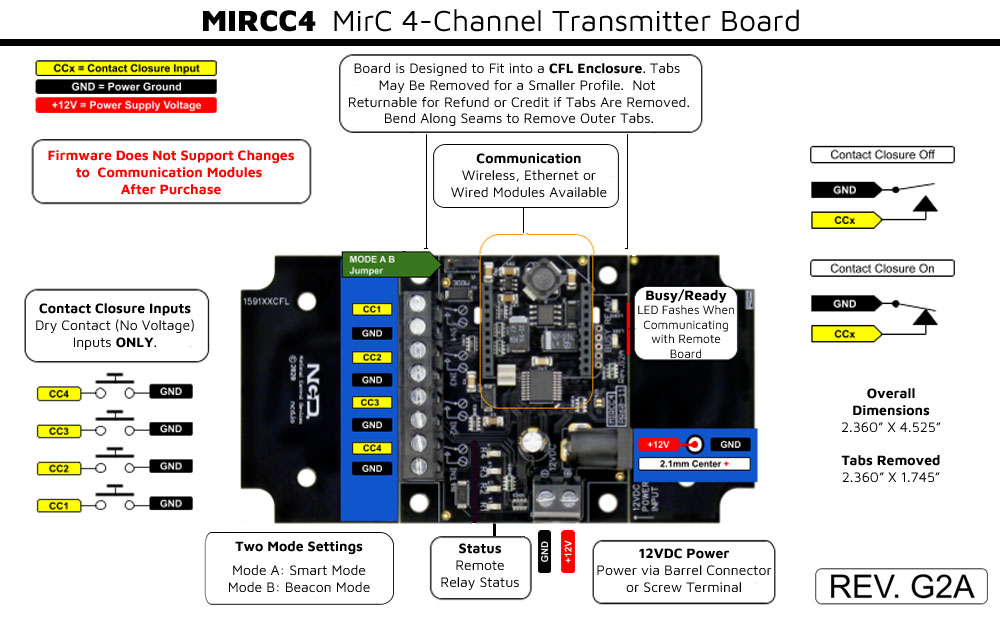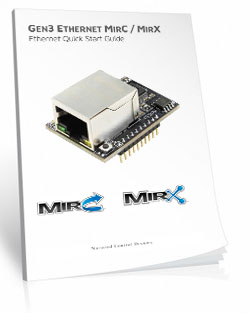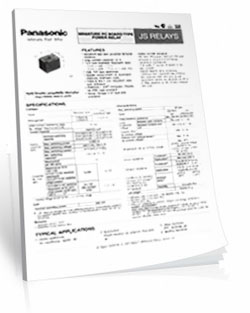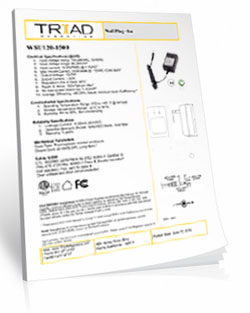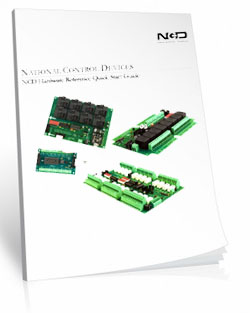Contact Closure Over IP 4-Channel 5-Amp
MIRCR45_MCNET
Contact Closure Over IP
Replace long cable runs or avoid costly wiring altogether with the MirCR45_MCNET. This paired system uses a dry contact (no voltage) inputs on the Sender board to activate relays on the Receiver board across your local network.Close the contact → Relay Energizes (Turns On)
Open the contact → Relay Turns Off
Reliable Remote Relay Control - Right Over Your Network!
Switch From One Location - Control Another
Activate a gate, door lock, entry system, pump, or any dry contact device in a different room, building, or location - as long as both boards are connected to the same LAN.
Contact Closure Over IP 4-Channel 5-Amp
MIRCR45_MCNETContact Closure Over IP at a Glance
- 4 5-Amp Relay Installed
- Single Pole Double Throw (SPDT) Relay
- Wire to Normally Open or Normally Closed Position
- 12 Guage Solid Core Wire Capacity
- Temperature Rating -40° C to 85° C - System Configuration
- Sender Board Remotely Controls the Receiver Board
- Sold as a Pair
- 4 Contact Closure Inputs on the Sender Board
- 4 Relay Outputs on the Receiver Board
- Network Connectivity
- Plugs Into Your Router
- Contact Closures Across Your LAN
- Static IP Required for Reliable Communication
- Sender Board Shows Status of Relays
LAN Connection ONLY
These boards talk to each other over your local network, not the internet. You'll just need both boards on the same LAN with static IP addresses so they can stay connected and easy to reach.
Contact Closure Over IP
Some Setup Required
MIRCR15_MCNET controllers are sold in married pairs - you'll receive both boards shown when you purchase this set. These boards let you control a relay over your Local Area Network (LAN) using a simple dry contact input (no voltage).A small amount of setup is required to pair the boards. Using the free NCD5500 Configuration Software, one board is configured as a server and the other as a client (either board can be assigned either role). The client board is programmed with the IP address of the server board, which links the pair together.
When the dry-contact circuit on the sender board is closed, the relay on the receiver board energizes. When the circuit opens, the relay turns off - simple, reliable remote control over your network.
LAN Connection Only
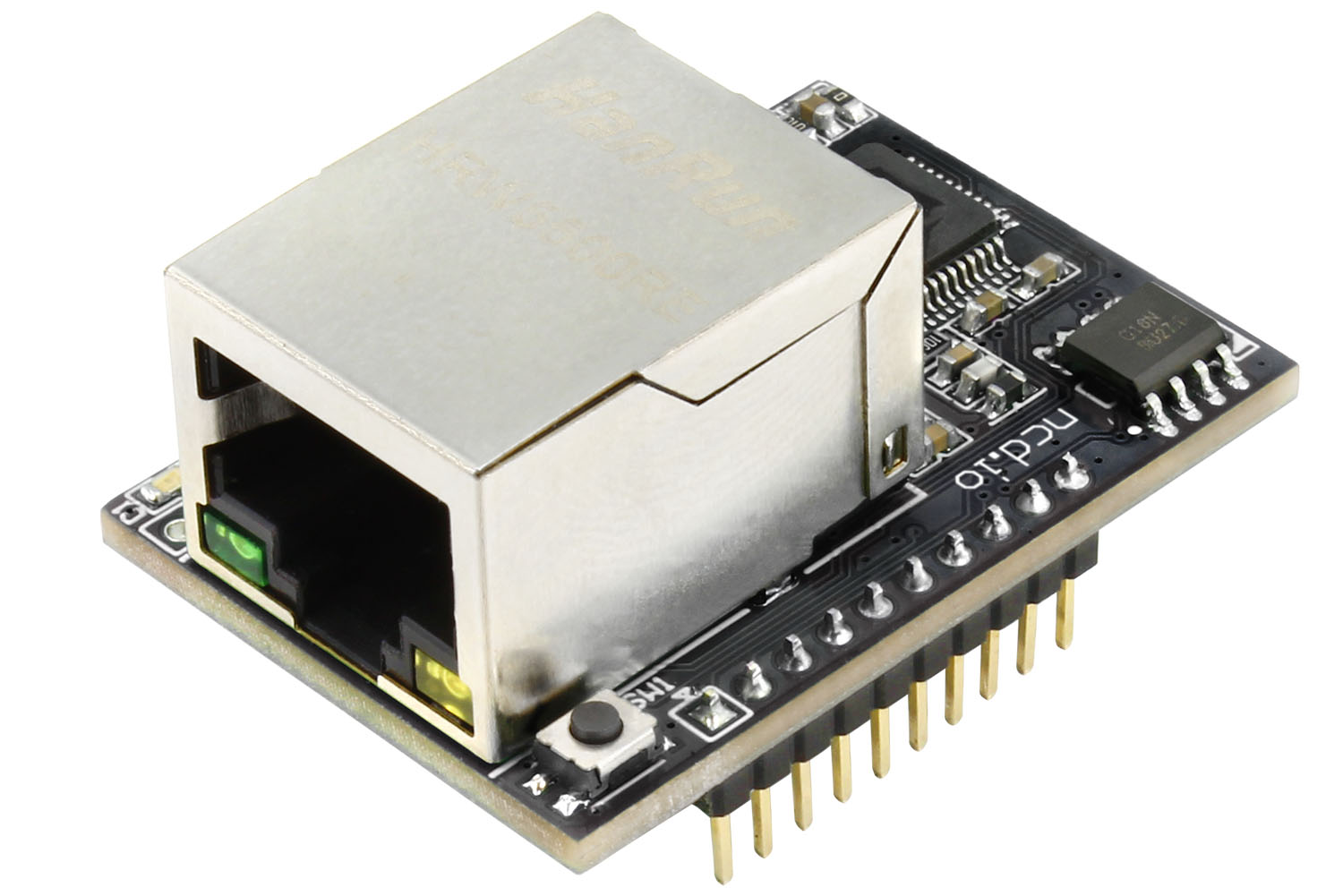 ⚠️ Important: These boards do not communicate over the public internet. Both boards must be on the same Local Area Network.
⚠️ Important: These boards do not communicate over the public internet. Both boards must be on the same Local Area Network.
Each board requires a static IP address. We strongly recommend assigning IPs outside your router's DHCP range to prevent address conflicts.
Communication between the boards uses a TCP socket. The port number is user-configurable; in our testing, we used port 2101. This detail may be important when boards are installed on different subnets.
Please note: Relay Pros / NCD cannot provide technical support for complex or managed network environments. Network configuration should be handled by your network administrator.
Location Is Not an Issue
Ethernet-enabled MirC boards are ideal for applications where wireless isn't an option and running control wire isn't practical. Physical distance doesn't matter - as long as both boards are on the same network, they'll communicate reliably.Windows Based Setup
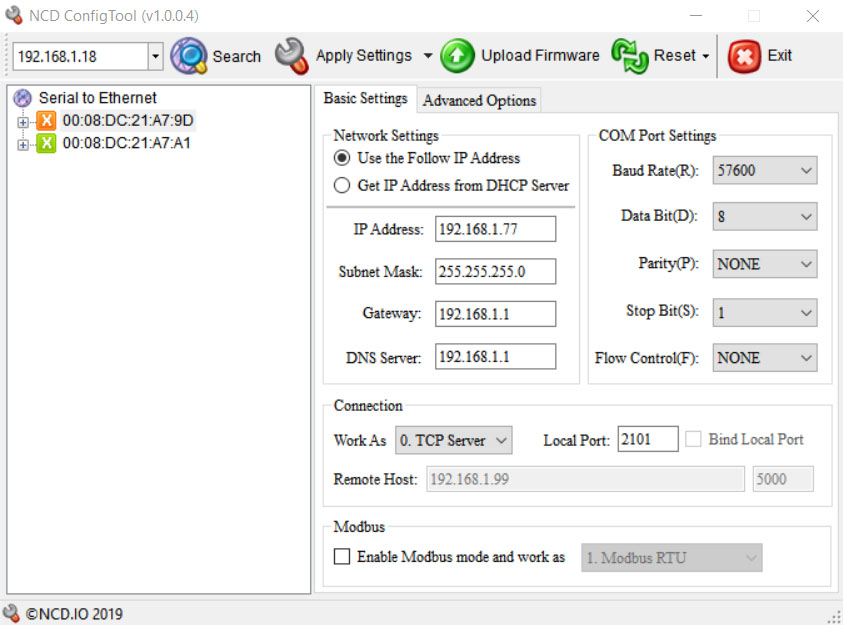 Initial configuration requires a Windows computer connected to the same network as the boards, using the free configuration software.
Initial configuration requires a Windows computer connected to the same network as the boards, using the free configuration software.
Out of the box, both boards start in DHCP mode, so a managed network is required during initial setup. Once configuration is complete, the boards can be installed and operated on an unmanaged network with no issue.
Multiple MirC Pairs?
Multiple MirC IP pairs can operate on the same network without interference. Each pair is linked using the unique IP addresses of the installed Ethernet modules, ensuring clean, independent operation across multiple systems.Is This Right for Your Application?
The MirC IP version is a great fit if:
- Both locations are already connected to the same Local Area Network
- Running control wire or using wireless RF isn't practical or permitted
- You want reliable relay control over Ethernet
- You're comfortable assigning static IP addresses or have access to a network administrator
- The system will remain inside a private LAN (not over the internet)
- The two locations are not on the same network
- You need communication over long distances without network infrastructure
- The installation site doesn't allow Ethernet access
- You want a plug-and-play solution with minimal configuration
Dry Contact Input ONLY
Inputs on the MirC Sender Board are designed for dry contacts only - no voltage needed. Applying voltage can damage the board, so simple contact closures are the way to go.
MirC Board Features
MirC Relay
MirC boards come in married pairs, letting you control a relay using a simple dry contact - no voltage input. That contact can come from a switch, a sensor, another relay - anything that can close a dry contact circuit.When the input contact is closed, the relay stays energized. When the contact opens, the relay turns off. So the relay will follow either momentary or toggle-style inputs depending on what you wire into it.
Each MirC pair is built to handle tough environments - heat, cold, vibration - you name it. These boards are workhorses, and they're designed to stay that way.
Contact Closure Inputs
 Inputs on MirC controllers accept dry contact only - absolutely no voltage should ever be applied. Applying voltage to an input will damage the board, so keep it clean and simple: contact closure only.
Inputs on MirC controllers accept dry contact only - absolutely no voltage should ever be applied. Applying voltage to an input will damage the board, so keep it clean and simple: contact closure only.
Relay Outputs
MirC relays act as dry-contact switches. They don't output voltage - they simply open or close the circuit feeding your device.Each relay is rated for 240 VAC or 24 VDC. For full electrical specifications and relay models, check out the Data Sheets tab above.
Status of Remote Relays
Both boards include LEDs that show the real-time status of the relay on the remote board. Thanks to true 2-way wireless communication, status indicators stay accurate.If communication drops, the status LED turns off so you know immediately. Every MirC controller also includes a Busy/Ready LED:
- A flashing Busy LED means the remote board received and accepted your input.
- If the Busy LED doesn?t flash, the other board is out of range or unable to respond.
SPDT Relay Installed
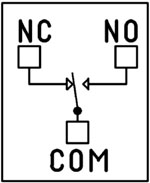 SPDT (Single Pole Double Throw) relays include three terminals: Common (COM), Normally Open (NO), and Normally Closed (NC)
SPDT (Single Pole Double Throw) relays include three terminals: Common (COM), Normally Open (NO), and Normally Closed (NC)
- When the relay is off, COM is connected to NC.
- When the relay is energized, COM switches to NO.
2 Million+ Cycles
ProXR relays are built for longevity - expect years of reliable operation and millions of mechanical cycles. Every board ships with a 5-year warranty and 30-day money-back guarantee.Break-A-Way Tabs for a Smaller Design
Need a smaller footprint? The MirC PCB includes Break-A-Way Tabs, allowing the board to fit into optional undrilled enclosures or tight-space installations.Essential Power Requirements
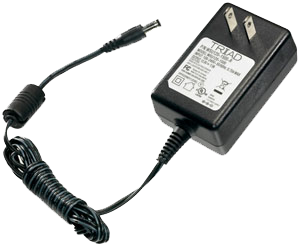 Clean, regulated power is critical.
Clean, regulated power is critical.A stable 12VDC supply ensures both the relay coils and onboard firmware operate correctly. Unstable or noisy power can cause improper switching or communication issues.
We recommend the PWR12-US (120VAC → 12VDC @ 1.25A) or our international supply with interchangeable adapters.
Learn More
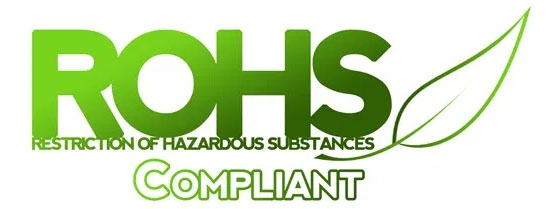
RoHS Compliant & Lead-Free
All MirC controllers are built with RoHS-compliant components and lead-free solder.5-Yeary Warranty & Guarantee
Every MirC controller is covered by:- 5-Year Functional Warranty
- 30-Day Money-Back Guarantee
Shipping
All boards ship directly from our Missouri facility. Each unit is built and tested at the time of order - please allow 3 - 5 days for production. We ship primarily through UPS, but we're happy to use FedEx or DHL for international orders when you provide your account number. Questions? Call us at 800-960-4287 or email sales@relaypros.com.Induction Suppression
 One of the most important parts of relay control - yet the most commonly overlooked - is inductive load protection.
One of the most important parts of relay control - yet the most commonly overlooked - is inductive load protection.
Anything with a magnetic coil (motors, solenoids, transformers, etc.) generates high-voltage "kickback" when switched. Without a suppression capacitor, that spike can:
- Shorten relay lifespan
- Cause electrical noise that disrupts the microcontroller
- Trigger unexpected shutdowns
- Require power cycling to restore communication
Contact Closure Relay Is Here!
A more streamlined manufacturing process brings a more durable, reliable and better relay board to the market. Here's a lists of great features:- Single Pole Double Throw Relays Installed
- Wire to Normally Open or Normally Closed Position
- 12 Guage Solid Core Wire Capacity - Screw Terminal Contact Closure and Relay Connections
- Break-A-Way Tabs Lets you Decide the Board's Size
- Temperature Rating -40° C to 85° C
- RoHS Compliant
User Friendly Board Design

- Control Relay from a Dry Contact (No Voltage)
- Inputs on Sender Board Control Relays on Receiver Board
- Sender Board Displays Status of Remote Relays
MirC Features
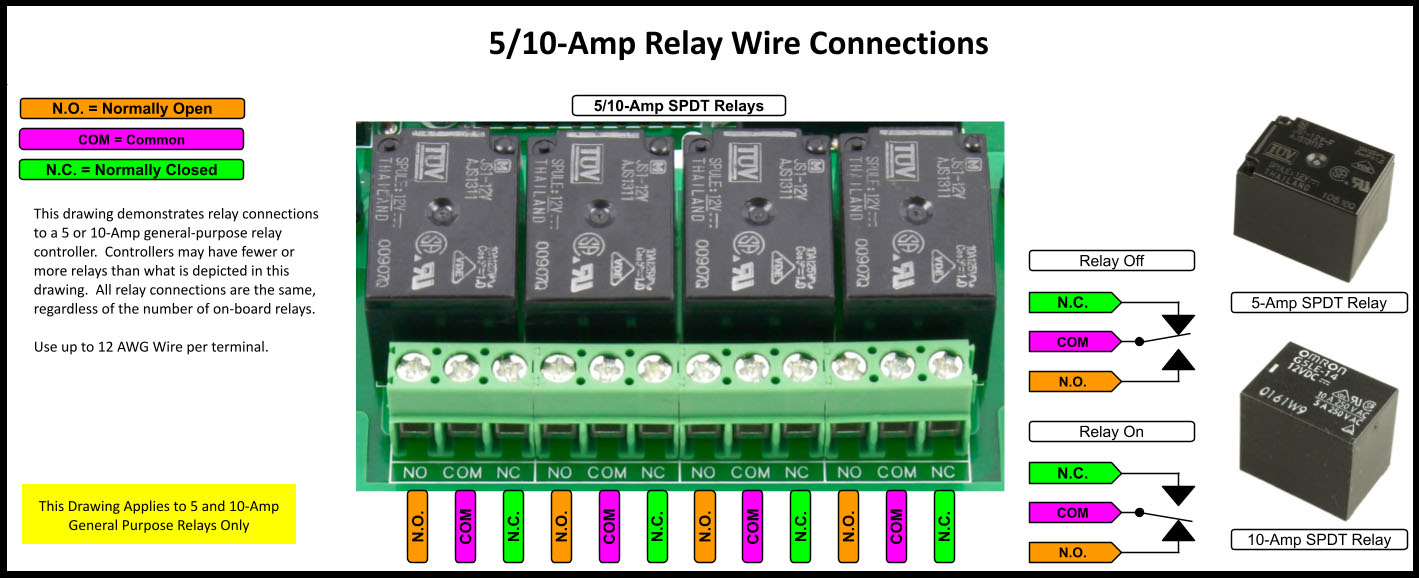
Easy Configuraton
You'll configure this board using the NCR5500 Ethernet Configuration Software - a Windows app that makes setup quick and simple.
MCNET / MXNET Setup
Before You Start (Requirements)
These boards communicate over your Local Area Network - not the public internet. Both boards must be on the same LAN and assigned a static IP address. They do not work if the boards are plugged directly into each other or directly into a computer - they must be connected through a LAN.We strongly recommend assigning IPs outside your router's DHCP range to avoid conflicts.
If this installation is part of an IT-managed network, share this guide with your network administrator before beginning.
Static IP Required
During configuration, you'll designate one board as the server and the other as the client. Each board also requires a static IP address. If the boards are left on DHCP and the router power cycles, the router may assign new IP addresses, which means the client board may no longer know where to find the server board - communication stops cold. Assigning static IPs prevents that.We recommend assigning addresses outside your router's DHCP range. One board will act as the server while the other acts as the client, connected through a TCP socket. You can choose any port number you like - in our setup we used port 2101. This can matter if the boards are on separate subnets.
Relay Pros / NCD can't provide support for complex network setups - for that level of configuration, your network admin is the one to loop in.
Windown Configuration
Setup requires the free configuration software and a Windows computer connected to the same network as the boards.Managed Network Required for Setup
Out of the box, both boards are set to DHCP mode. That means configuration must begin on a managed network.Once setup is complete, the boards may be installed on an unmanaged network, no problem.
Configuration
Initial setup
- Download and install the NCD5500 NCD 5500 Configuration Software.
- onnect standard Ethernet cables to both boards, attach them to the network, and power them with a regulated 12VDC supply.
- Open the NCD5500 Configuration software.
- Click Search until both boards appear in the list.
Each board will be identified by its MAC address, which is also printed on the Ethernet module - helpful for telling them apart.

First board Configuration (Server)
- Select one of the boards to open its settings.
All steps are under Basic Settings - nothing needed in Advanced Settings. - Set the baud rate to 57600.
- Under Network Settings, switch to Use the following IP address.
- Assign a static IP address and enter Subnet Mask, Gateway, and DNS Server as required for your network.
- Under Connection, set Work As to TCP Server.
- Enter a Local Port (any port except 80). We used 2101 in our testing.
- Click Apply Settings.
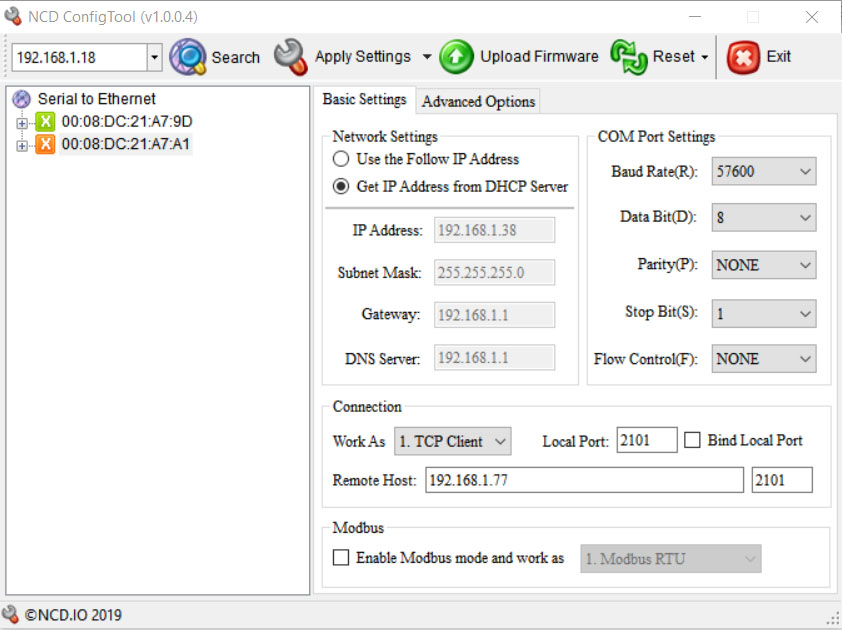
Second Board Configuration (Client)
- Select the second board to open its settings.
- Set the baud rate to 57600.
- Switch Network Settings to Use the following IP address.
- Assign a different static IP address, and enter Subnet Mask, Gateway, and DNS Server.
- Under Connection, set Work As to TCP Client.
(Local Port is not required here.) - Enter the Server Board's IP address into the Remote Host field.
- Enter the Server's Local Port number in the Port field.
- Click Apply Settings.
Final Testing
Once settings are applied on both boards, communication should establish automatically.You can verify a successful TCP connection two ways:
- The red LED on the Ethernet module (next to the metal jack) will be solid on.
- The Busy/Ready LEDs on the boards will flash periodically, confirming communication.
Building a Power Budget
This controller runs best between 9-14VDC for reliable performance. Use the tables below to build a power budget that fits your setup - including your communication module and how often relays will activate.
Power & More
Board Performance Ratings
This tab brings together the essential performance ratings you'll want to know for NCD SPDT Relay Controllers and their supported communication modules. You'll find practical electrical requirements, power consumption estimates, operating limits, relay timing details, and more-all based on typical 12VDC operation at 70°F (21°C). Think of it as a reliable snapshot of how our hardware behaves under real-world conditions. Because every installation is unique, some values are estimates and may evolve as designs and testing continue. Use this information as a planning tool to help you choose the right controller, build an accurate power budget, and understand the capabilities built into every NCD SPDT relay board.The SPDT Relay
 SPDT (Single Pole Double Throw) relays include three terminals: Common (COM), Normally Open (NO), and Normally Closed (NC)
SPDT (Single Pole Double Throw) relays include three terminals: Common (COM), Normally Open (NO), and Normally Closed (NC)
- When the relay is off, COM is connected to NC.
- When the relay is energized, COM switches to NO.
2 Million+ Cycles
ProXR relays are built for longevity - expect years of reliable operation. The SPDT relay is rated for millions of mechanical cycles. Every board ships with a 5-year warranty and 30-day money-back guarantee.SPDT Relay Board
SPDT Relay Controller Specifications
This table outlines key performance ratings for all NCD SPDT Relay Controllers, based on 12VDC operation at 70°F (21°C). Many values are estimated and may be updated over time. Some ratings reflect standard, out-of-the-box settings without performance optimizations applied.Processing times can vary depending on background services and the commands you use. Standby power values assume no communication module is installed and no relays are active. For a more accurate power estimate, be sure to include the consumption of any installed communications module and any energized relays.
| Specs of NCD SPDT Relay Boards | Minimum | Nominal | Maximum | Notes |
| Operational Voltages | 10VDC | 12VDC | 15VDC | |
| Standby Power Consumption | 35mA | 100mA | 200mA | No Active Relays, No Com Module |
| Relay Power Consumption | 28mA | 35mA | 60mA | Consumption of Each Activated Relay |
| Operational Temperature Range | -40°F (-40°C) | 70°F (21°C) | 185°F (85°C) | Theoretical Component Limits Shown |
| Storage Temperature Range | -67°F (-55°C) | 70°F (21°C) | 185°F (85°C) |
Theoretical Component Limits Shown |
| Operational Ambient Air Humidity | 0% | 50% | 70% | Non-Condensing Humidity Values Shown |
| Relay Activation Time | 4ms | 5ms | 10ms | Needs Further Validation |
| Relay Deactivation Time | 5mS | 10mS | 15mS | Needs Further Validation |
Communication Modules
Communication Module Specifications
This table provides a quick, clear overview of all NCD Communication Modules. While each module operates at 3.3VDC, the values shown here reflect the impact on a 12VDC master controller at 70°F (21°C). Use the maximum ratings for power-budget planning - they represent short-term peak consumption and may include estimated values that are updated as modules evolve.| Specs of NCD Communication Modules | Minimum | Nominal | Maximum | Notes |
| Operational Temperature Range | -40°F (-40°C) | 70°F (21°C) | 185°F (85°C) | Theoretical Component Limits Shown |
| Storage Temperature Range | -67°F (-55°C) | 70°F (21°C) | 185°F (85°C) | Theoretical Component Limits Shown |
| Operational Ambient Air Humidity | 0% | 50% | 70% | Non-Condensing Humidity Values Shown |
| USB Module Power Consumption | N/A | N/A | N/A |
USB Modules are Powered by the USB Port Do Not Consume Device Current |
| RS-232 Module Power Consumption | 10mA | 20mA |
|
|
| Ethernet Module Power Consumption | 58mA | 82mA | 100mA | |
| WiFi Bluetooth USB Module Power Consumption | 37mA | 50mA | 100mA | Up to 300 Foot Indoor Wireless Range, Unobstructed. Up to 50 Foot Range Through Walls |
| 900MHz Wireless Module Power Consumption | 13mA | 30mA | 50mA | Up to 1,000 Foot Indoor Wireless Range, up to 2 Mile Outdoor Wireless Range using Included Antennas. Up to 28 Miles Outdoor Wireless Range using High-Gain Antennas. |
| KFX Wireless Key Fob | 11mA | 15mA | 25mA | Up to 200 Feet Outdoor Wireless Range using 1, 2, 3, 4, or 5 Button Key Fobs. Up to 700 Feet Outdoor Wireless Range using 8-Button Remotes |
A/D Inputs
AD8 Analog Input Usage Notice
Analog inputs should never have voltage applied when the controller is powered down. If your application requires voltage to remain on an input, add a 220-ohm current-limiting resistor to each channel to protect the controller from damage.Keep all analog inputs within the 0 - 5VDC range - exceeding this limit can permanently damage the on-board CPU. Most inputs include a 10K pull-up or pull-down resistor to keep the line stable when unused, but note that this resistor may introduce a slight bias in readings for certain sensors.
Accessories
Enclosure Available
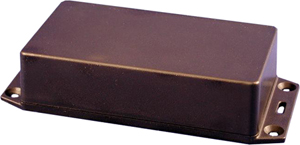 The CFL Enclosure is an undrilled, non-waterproof enclosure and is available at checkout for the Sender Board.
The CFL Enclosure is an undrilled, non-waterproof enclosure and is available at checkout for the Sender Board.CFL Spec Sheet
CAD Drawing: CFL CAD Drawing
3D Model: CFL_3D
Enclosure Available
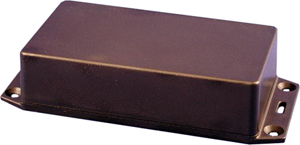 The DFL Enclosure is an undrilled, non-waterproof enclosure and is available at checkout for the Receiver Board.
The DFL Enclosure is an undrilled, non-waterproof enclosure and is available at checkout for the Receiver Board.DFL Spec Sheet
CAD Drawing: DFL CAD Drawing
3D Model: DFL_3D
Power Supply Available
 The PWR12 is regulated power supply providing clean power necessary for
the performance of these boards. The PWR12 US power supply is a 120VAC to 12VDC 1.25A 60Hz regulated
power supply and it plugs into the barrel connector on the board. The output connector is a 2.1mm I.D. x 5.5mm
O.D. x 9.5mm R/A barrel connector.
The PWR12 is regulated power supply providing clean power necessary for
the performance of these boards. The PWR12 US power supply is a 120VAC to 12VDC 1.25A 60Hz regulated
power supply and it plugs into the barrel connector on the board. The output connector is a 2.1mm I.D. x 5.5mm
O.D. x 9.5mm R/A barrel connector.
Click Here for More
Induction Suppression
 Controlling
an inductive load using our relay controllers requires the use of induction suppression capacitors. The purpose of this capacitor
is to absorb the high voltages generated by inductive loads, blocking them from the contacts of the relay. Without this capacitor,
the lifespan of the relay will be greatly reduced. Induction can be so severe that it electrically interferes with the microprocessor
logic of our controllers, causing relay banks to shut themselves down unexpectedly.
Click Here for More
Controlling
an inductive load using our relay controllers requires the use of induction suppression capacitors. The purpose of this capacitor
is to absorb the high voltages generated by inductive loads, blocking them from the contacts of the relay. Without this capacitor,
the lifespan of the relay will be greatly reduced. Induction can be so severe that it electrically interferes with the microprocessor
logic of our controllers, causing relay banks to shut themselves down unexpectedly.
Click Here for More
What Is Relay Logic?
Relay logic lets you wire relays in ways that produce specific control outcomes. In short, it's how you arrange relays to perform exactly the switching behavior your application needs.
Get a printout of this page
Relay Logic
Relay Wiring Samples
This page provides simple examples showing how to wire a single relay - or multiple relays - for common switching applications. We use a light as the example load, but you can substitute a gate controller, security panel input, dry contact device, motor trigger, or most other switched loads. These wiring samples demonstrate different ways to connect relays to achieve the switching behavior you need.
Relay Types
SPDT Relay
 SPDT (Single Pole Double Throw) relays include three terminals: Common (COM), Normally Open (NO), and Normally Closed (NC).
SPDT (Single Pole Double Throw) relays include three terminals: Common (COM), Normally Open (NO), and Normally Closed (NC).
- When the relay is off, COM is connected to NC.
- When the relay is energized, COM switches to NO.
Your load can be wired to either the NO or NC terminal depending on whether you want the device to turn on when the relay activates or when it releases. Examples below demonstrate both wiring methods. The SPDT relays offered on this site are 5-Amp, 10-Amp and 20-Amp models.
SPST Relay
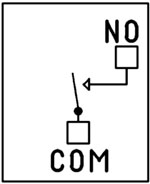
SPST (Single Pole Single Throw) relays provide two terminals: Common (COM) and Normally Open (NO).
When the relay coil is energized, COM connects to NO to power the load. The only SPST relays offered on this site are our 30-Amp models. All SPST examples shown on this page apply to these relays as long as the example does not require a Normally Closed terminal.
DPDT Relay

A DPDT (Double Pole Double Throw) relay contains two SPDT switches that operate together.
- Each side includes its own COM, NO, and NC terminals.
- Both internal switches change state at the same time.
This allows you to control two independent circuits with one relay. Wiring for each side of a DPDT relay follows the same
rules as an SPDT relay, so the examples on this page apply directly. We offer the DPDT relays in 1-Amp, 3-Amp and 5-Amp models
on ProXR boards starting at 8 relays.
Relay Grouping in the ProXR Command Set lets you combine individual relays to function like a DPDT relay using separate channels. This is ideal when you need to control multiple relays simultaneously or exceed the 5-Amp switching limit of our standard DPDT relays.
Relay Logic Examples
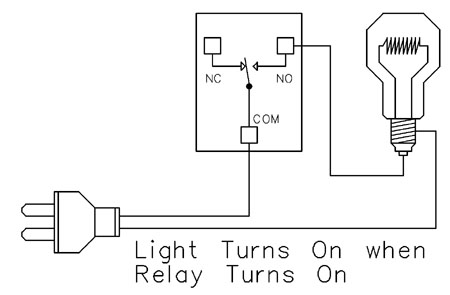
Example 1 - Simple Off/On Control
This example shows the most basic way to use a relay to switch a device such as a light. When the relay energizes, its NO (Normally Open) contact closes to COM (Common), completing the circuit and turning the light on.Only a single power wire is switched in this setup, making it the simplest method for controlling a light - or any device - using a relay.
Use this example for switching a light or any device you want to power only when the relay is on.
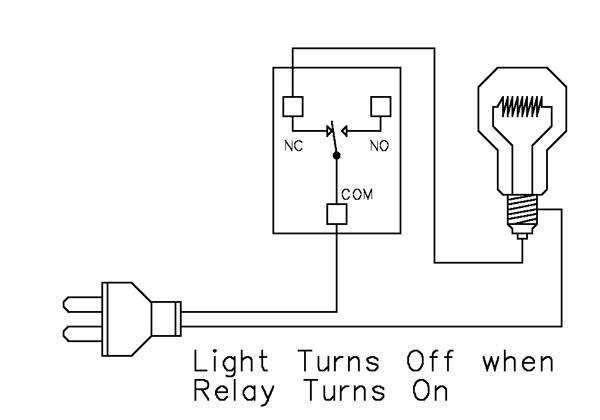
Example 2 - Simple On/Off (Using NC Contact)
This wiring method keeps the device on by default. The relay switches a single power wire through the COM (Common) and NC (Normally Closed) terminals.When the relay is not energized, the NC contact is closed to COM and the light remains on.
When the relay energizes, the NC contact opens, interrupting power and turning the light off.
This approach is ideal for devices that stay on most of the time, reducing relay wear since it doesn't need to remain energized to keep the device powered. It's also a useful method for power-cycling equipment - energizing the relay momentarily will turn the device off.
Example 3 - AND Logic Using Two Relays
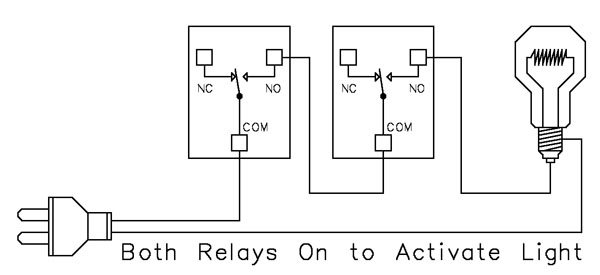 This example shows how two relays can work together so a light turns on only when both relays are energized. This creates an AND Logic condition:
This example shows how two relays can work together so a light turns on only when both relays are energized. This creates an AND Logic condition:Relay 1 AND Relay 2 must be on for the light to receive power.
A single power wire is switched, but it must pass through both relay contacts before reaching the light. This setup is ideal when two conditions must be met at the same time - such as requiring input from multiple sensors or system parameters.
MirC/MirX Users: This wiring requires two contact closure inputs on the sender board before the receiver's relay activates. Use this approach when two independent outputs must close before turning on the light.
- For example, a light could turn on only when:
- A light sensor detects it's dark AND
- A motion sensor detects activity in the room
Example 4 - AND Logic Using Three Relays
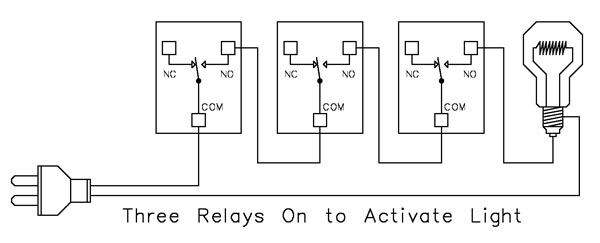 This example expands on the previous AND Logic concept. Here, the light will turn on only when all three relays are energized:
This example expands on the previous AND Logic concept. Here, the light will turn on only when all three relays are energized:
Relay 1 AND Relay 2 AND Relay 3 must be on for power to reach the light.
A single power wire is routed through all three relay contacts. Wiring from the NO (Normally Open) of Relay 1 to the COM (Common) of Relay 2, then from the NO of Relay 2 to the COM of Relay 3, creates a series path that requires every relay to close before the light can activate.
This method can be scaled easily - just continue wiring NO of each relay to the COM of the next relay. Add as many relays as needed to meet your logic or safety requirements.
Example 5 - AND/OR Logic with Override
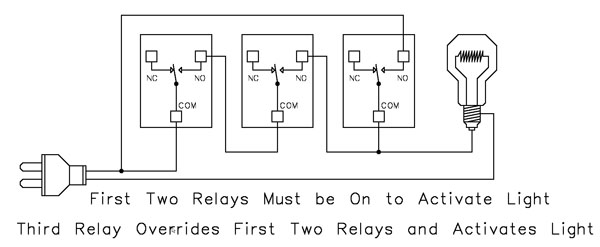 This example demonstrates a combined AND/OR logic setup. The light will turn on when:
This example demonstrates a combined AND/OR logic setup. The light will turn on when:
- Relay 1 AND Relay 2 are both energized OR Relay 3 is energized (override)
- For example:
- Relay 1 = night/day sensor
- Relay 2 = motion sensor
- Relay 3 = manual override (local switch)
A/D Board Users: The Relay Activator function on any A/D board or ProXR Lite board lets you connect a button or switch to any A/D input. This input can then control the override relay, giving you a convenient local button to manually override the first two relays.
MirC/MirX Users: Add a manual button or switch to trigger the third relay when you need direct control instead of sensor-driven control.
Reactor Users: A local button or switch can be wired to the third relay input to provide a manual override for sensor-based logic.
Example 6 - OR Logic (Either Relay Activates)
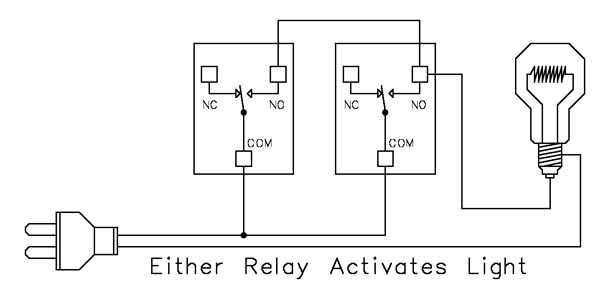 This example demonstrates OR Logic - the light will turn on when either relay is energized. Only one power wire is switched, but it can pass through Relay 1 or Relay 2 to reach the light.
This example demonstrates OR Logic - the light will turn on when either relay is energized. Only one power wire is switched, but it can pass through Relay 1 or Relay 2 to reach the light.
- If Relay 1 activates, the light turns on
- If Relay 2 activates, the light turns on
- If both activate, the light remains on
- A timer controlling one relay, with a manual or secondary control for the other.
- Two sensors where either condition (motion detected or low light, for example) should activate the light.
MirC/MirX Users: Wire two contact closure inputs into the sender board - either input can trigger the receiver relay to control the light.
Example 7 - 3-Way Switch (Relay-Based 3-Way Control)
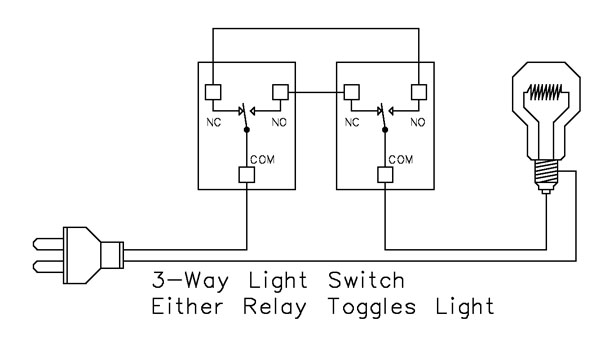 This example shows how to create a 3-way light switch setup using relays. A traditional 3-way circuit allows two switches to control the same light from different locations. In this wiring sample, each physical switch is replaced by a relay - but the operation is the same.
This example shows how to create a 3-way light switch setup using relays. A traditional 3-way circuit allows two switches to control the same light from different locations. In this wiring sample, each physical switch is replaced by a relay - but the operation is the same.
Only one power wire is switched, and the relays toggle the light depending on their current state.
- Activating either relay will toggle the light
- Activating both relays at the same time has the same effect as flipping both switches at once
Example 8 - DC Motor Direction Control
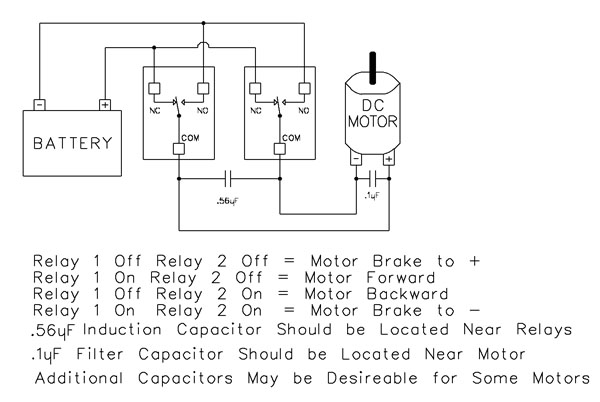 This example demonstrates how to control the direction of a DC motor using two relays. By changing how the motor's leads connect to power, you can run the motor forward, reverse, or place it in a brake state. Braking is achieved by tying both motor terminals to the same power connection, which stops rotation through Faraday's Law.
This example demonstrates how to control the direction of a DC motor using two relays. By changing how the motor's leads connect to power, you can run the motor forward, reverse, or place it in a brake state. Braking is achieved by tying both motor terminals to the same power connection, which stops rotation through Faraday's Law.
- Relay Operation Summary
- Relay 1 Off / Relay 2 Off → Motor Brake to +
- Relay 1 On / Relay 2 Off → Motor Forward
- Relay 1 Off / Relay 2 On → Motor Reverse
- Relay 1 On / Relay 2 On → Motor Brake to -
- The induction suppression capacitor prevents the relay from shutting off due to motor back-EMF
- The 0.1µF filter capacitor reduces electrical noise, especially useful when powering sensitive electronics such as radios or amplifiers.
- Capacitor Placement
- Place the induction suppression capacitor near the relays
- Place the filter capacitor near the motor
- Additional capacitors may be needed for certain motors
Motors draw significantly more current at startup than during continuous operation - often 2-3 times their rated running current. For example, a motor rated at 5A (125VAC) may require 10-15A to begin turning. Always select a relay that exceeds the motor's initial inrush current, not just its running current. In this case, a 20-30A relay provides optimal performance and longevity.

